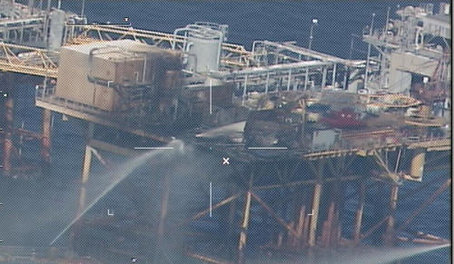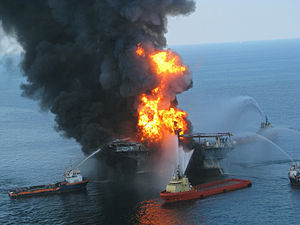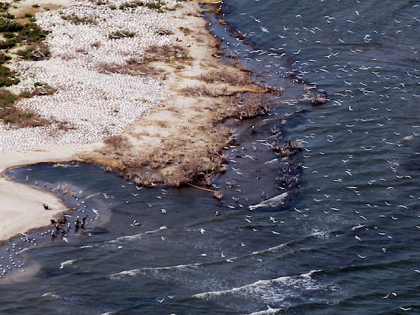http://www.wwltv.com/news/eyewitness/davidhammer/Black-Elk-issued-41-violations-following-report-231808061.html

GULF OF MEXICO – Commercial vessels spray water to extinguish a platform fire on board West Delta 32 approximately 20 miles offshore Grand Isle, La., in the Gulf of Mexico. First responders medevaced nine of the platform’s 22 personnel to nearby rigs. U.S. Coast Guard photo.
wwltv.com
Posted on November 13, 2013 at 4:34 PM
Updated yesterday at 6:00 PM
David Hammer / Eyewitness News
Email: dhammer@wwltv.com | Twitter: @davidhammerWWL
PLAQUEMINES, La. — Following up on a damning investigation report last week, federal offshore regulators issued 41 formal violations against Black Elk Energy and its contractors for their role in causing an explosion last year that killed three welders on a platform off Plaquemines Parish.
Three Filipino nationals – Ellroy Corporal, Jerome Malagapo and Avelino Tajonera – were killed by the explosion on Black Elk’s West Delta 32 E Platform on Nov. 16, 2012. The federal Bureau of Safety and Environmental Enforcement issued its investigation report Nov. 4, finding that Black Elk and contractors Compass Engineering and Consultants, Grand Isle Shipyards/DNR and Wood Group PSN failed to follow their own basic safety plans.
The investigation concluded that Black Elk failed in its supervisory role and its contractors communicated poorly about whether flammable gas had been properly purged from tanks and pipes before the workers started cutting with blow torches.
The report states that Wood Group’s supervisor left a lower-level employee without proper training to sign and approve a welding permit to cover the entire platform, rather than each welding location as rules require. Then, that employee turned the job over to a Grand Isle Shipyards supervisor based on a faulty understanding from a Compass consultant that all areas had been purged and were ready for hot work.
In fact, nobody had cleared the areas for hot work. The report describes how gas detectors that were supposed to be used to check the hot-work areas were not functioning properly and were left in their charging stations, but when workers complained, their Grand Isle supervisor told workers not to forget about it.
“According to the DNR workers, the GIS/DNR supervisor instructed the construction workers to hang the non-functioning gas detector up like a ‘decoration’ so everyone could at least see that they had one,” the report says.
The most serious violations still were issued to Black Elk, which is the lease-holder and ultimately responsible. Black Elk got 12 violations, or Incidents of Non-Compliance. Wood Group received 11 INCs and Compass and Grand Isle Shipyards got nine each.
________________
http://www.forbes.com/sites/lorensteffy/2013/11/14/fail-fine-repeat-business-as-usual-for-some-offshore-drillers/
Forbes
ENERGY | 11/14/2013 @ 9:53AM |456 views
Fail, Fine, Repeat: Business As Usual For Some Offshore Drillers

In the Gulf, an operator’s safety track record doesn’t seem to matter (Photo credit: Wikipedia)
Every oil company operating in the Gulf of Mexico must be terrified today after the harsh crackdown on Black Elk Energy by federal regulators. The feds hit the Houston-based offshore oil producer and three of its contractors with 41 citations related to a rig explosion last year that killed three workers. The companies could face – that’s right could face – civil penalties. Don’t worry, though, Black Elk and its contractors have 60 days to appeal the citations for “incidents of noncompliance.” Such fines often are negotiated down.
Black Elk has plenty of experience dealing with these types of citations. While 41 may seem like a lot, at the time of last year’s fatal accident, Black Elk already had been cited 315 times in the previous two years for rules violations and risky procedures. As recently as one month before that accident, regulators found that Black Elk “showed a disregard for the safety of personnel” in another accident that sent six workers to the hospital.
In addition to Black Elk, the latest round of citations included its contractors, Grand Isle Shipyard of Galliano, La., which employed the workers who were killed, Compass Engineering & Consultants of Lafayette, La., and Wood Group PSN of Aberdeen, Scotland.
The Bureau of Safety and Environmental Enforcement found that the contractors didn’t clear pipes of flammable hydrocarbons before they began welding. As the operator, though, Black Elk is responsible for the overall safety on its rigs, and BSEE found that Black Elk’s safety procedures were lacking. One regulator described Black Elk as having “the antithesis of the type of safety culture that should guide decision-making” in offshore operations. The feds also told Black Elk to come up with a safety plan.
Shortly after the accident, Black Elk chief executive John Hoffman told me that BSEE’s investigation would vindicate his company and “shed light where it needs to be.” Clearly, he was wrong about the first part, but the BSEE investigation certainly sheds light on one of the dark realities of offshore safety – lax accountability. Federal regulators largely ignore the role of recidivism in safety violations. For all the talk of creating a “safety culture” the only consequences for not having one is being told to get one and, perhaps, some civil fines.
Even for small companies like Black Elk, the size of those fines is minimal. In 2011, for example, the average fine levied by BSEE for offshore safety violations was about $62,000. Black Elk, by comparison, had a fine last year that topped $307,000 after an inspection found a gas leak on one of its platforms that the company didn’t fix for more than 100 days. Black Elk has had three more civil penalties so far this year totaling more than $250,000.
The citations pile up like traffic tickets on the windshield of an abandoned car while lives continue to be lost.
Nuisance fines allow lax safety to persist in the Gulf because operators can engage in their usual tactics of denial – blaming contractors and complaining about burdensome regulations. What we have seen, though, both in shallow water operations like Black Elk’s, and deepwater disasters like BP’s Deepwater Horizon accident in 2010, is a steadfast refusal of regulators to consider an operator’s safety track record in allowing them continued access to the Gulf. That’s the one thing they care about most.
Until there’s stiffer consequences for major safety violations, business as usual will continue in the Gulf: fail, fine, repeat.
Special thanks to Richard Charter


